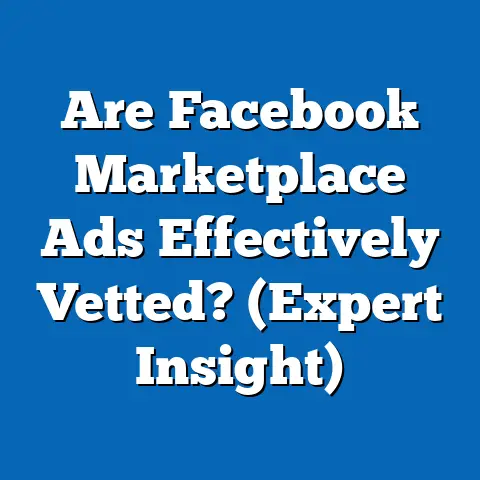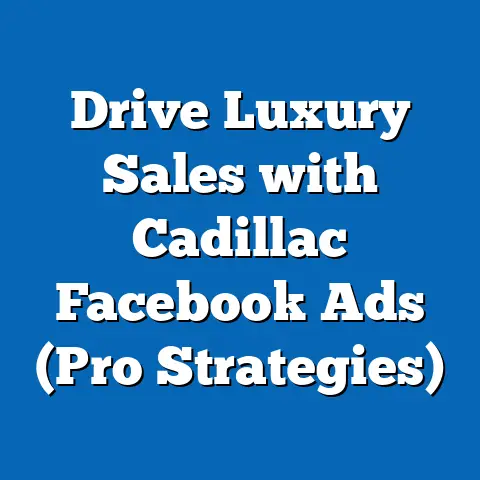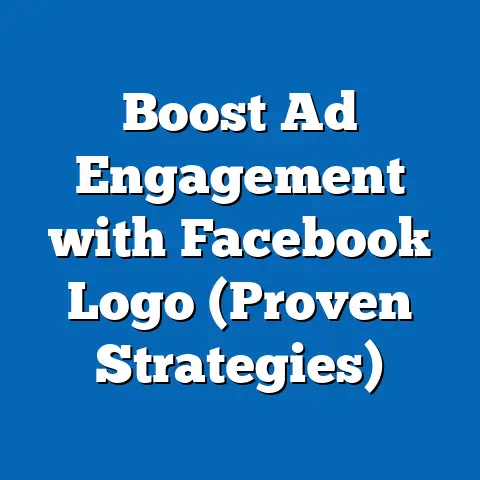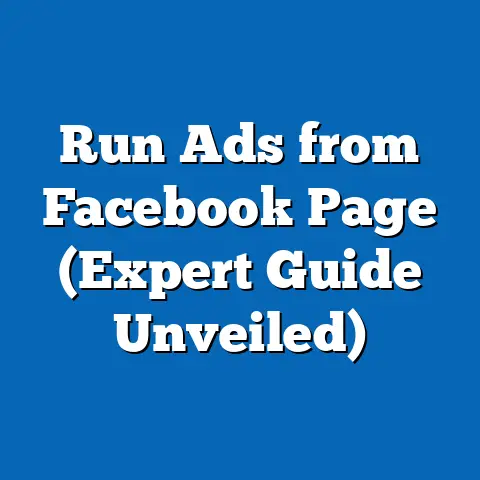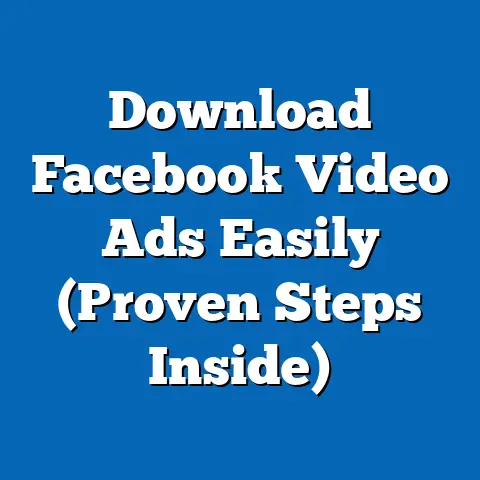Boost Facebook Ads Awareness (Proven Strategies Revealed)
In today’s fast-paced digital marketing landscape, are you spending your time and resources effectively to boost awareness through Facebook Ads? With over 2.9 billion monthly active users as of Q2 2023 (Meta, 2023), Facebook remains a dominant platform for advertising, offering unparalleled reach across diverse demographics. This fact sheet provides a comprehensive, data-driven analysis of proven strategies to enhance Facebook Ads awareness, supported by current statistics, demographic breakdowns, and trend analysis.
This report examines the latest data on Facebook advertising effectiveness, user engagement, and emerging trends to help marketers optimize their campaigns. We explore how different demographics interact with ads, highlight year-over-year shifts in ad performance, and present actionable strategies based on empirical evidence. Our goal is to equip businesses and marketers with the tools to increase brand visibility and engagement through targeted, efficient advertising on the platform.
Section 1: Current Landscape of Facebook Advertising
1.1 Overall Reach and Engagement
Facebook continues to be a powerhouse for digital advertising, with ad revenue reaching $31.5 billion in Q2 2023, a 12% increase from $28.2 billion in Q2 2022 (Meta, 2023). The platform’s average cost-per-click (CPC) stood at $0.97 in 2023, up from $0.86 in 2022, reflecting growing competition for ad space (WordStream, 2023). Meanwhile, the average click-through rate (CTR) for Facebook Ads across industries is 0.90%, though this varies widely by sector and audience targeting.
Engagement metrics reveal that video ads garner 6.01% higher engagement rates compared to static image ads, based on data from over 500,000 campaigns analyzed in 2023 (Socialinsider, 2023). Furthermore, 54% of users report discovering new products through Facebook Ads, underscoring the platform’s role in driving awareness (Hootsuite, 2023). These figures highlight the potential for businesses to capitalize on Facebook’s vast audience through strategic ad placement and content creation.
1.2 Year-Over-Year Trends
The past five years have shown a consistent upward trajectory in Facebook ad spending, with a 15% year-over-year increase in global ad spend from 2022 to 2023 (eMarketer, 2023). Notably, mobile ad impressions have risen by 20% since 2021, as 98.5% of users access the platform via mobile devices (Meta, 2023). This shift underscores the importance of mobile-optimized campaigns for maximizing reach.
Conversely, organic reach for business pages has declined, dropping to an average of 5.2% of followers in 2023 from 6.4% in 2020 (Socialbakers, 2023). This decline has pushed more businesses to invest in paid ads to maintain visibility. Additionally, the introduction of privacy changes, such as Apple’s iOS 14.5 update in 2021, has impacted ad tracking, with 62% of marketers reporting reduced targeting accuracy (Forbes, 2023).
Section 2: Demographic Breakdown of Facebook Ad Engagement
2.1 Age-Based Engagement
Facebook’s user base spans a wide age range, with distinct engagement patterns for ads across age groups. As of 2023, 25-34-year-olds constitute the largest demographic at 31.5% of total users, followed by 18-24-year-olds at 23.8% (Statista, 2023). Engagement rates are highest among 18-24-year-olds, with a CTR of 1.2%, compared to 0.7% for users aged 45-54 (WordStream, 2023).
Older demographics, particularly those aged 55+, show a growing presence on the platform, increasing from 10% of users in 2018 to 15% in 2023 (Pew Research Center, 2023). However, their interaction with ads is lower, with only 0.5% CTR, suggesting that content tailored to younger audiences may not resonate as effectively with this group. Marketers targeting older users report a 25% higher conversion rate for lifestyle and health-related ads compared to tech or entertainment categories (Socialinsider, 2023).
2.2 Gender-Based Engagement
Gender differences in ad engagement are less pronounced but still notable. Women make up 43.7% of Facebook users globally, while men account for 56.3% (Statista, 2023). Women exhibit a slightly higher CTR of 0.95% compared to men at 0.85%, with particular responsiveness to ads in beauty, fashion, and family-oriented categories (Hootsuite, 2023).
Men, on the other hand, show higher engagement with tech, gaming, and automotive ads, with a 15% higher conversion rate in these sectors compared to women (Socialbakers, 2023). These differences suggest that gender-specific targeting remains a valuable strategy for optimizing ad performance. However, gender-neutral campaigns focusing on universal themes like sustainability have seen a 10% increase in engagement across both groups since 2021 (eMarketer, 2023).
2.3 Geographic and Socioeconomic Variations
Geographic targeting plays a critical role in ad awareness, with 70% of ad impressions in 2023 concentrated in North America, Europe, and Asia-Pacific regions (Meta, 2023). The average CPC in North America is $1.10, significantly higher than in Asia-Pacific at $0.45, reflecting varying levels of market saturation and purchasing power (WordStream, 2023). Urban users are 30% more likely to engage with ads compared to rural users, driven by higher internet penetration and mobile usage in cities (Pew Research Center, 2023).
Socioeconomic status also influences ad interaction, with users in higher income brackets (earning $75,000+ annually) showing a 20% higher likelihood of clicking on premium product ads (Nielsen, 2023). Conversely, cost-conscious ads for budget-friendly products resonate more with lower-income users, achieving a 12% higher CTR in this demographic (Socialinsider, 2023). These disparities highlight the need for localized and income-sensitive ad strategies to boost awareness effectively.
Section 3: Proven Strategies to Boost Facebook Ads Awareness
3.1 Leveraging Video Content
Video ads are a proven tool for increasing awareness, with 62% of users reporting they are more likely to remember a brand after viewing a video ad compared to a static image (Hootsuite, 2023). Short-form videos (under 15 seconds) achieve a 35% higher completion rate than longer formats, making them ideal for capturing attention in crowded newsfeeds (Socialinsider, 2023). Additionally, incorporating captions increases engagement by 12%, as 85% of users watch videos without sound (Meta, 2023).
Brands using storytelling in video ads report a 20% increase in share rates, particularly among 18-34-year-olds (eMarketer, 2023). Live video content also shows promise, with 28% of marketers noting higher engagement during live streams compared to pre-recorded videos (Socialbakers, 2023). These trends suggest that dynamic, concise, and accessible video content is a cornerstone of effective awareness campaigns.
3.2 Optimizing Ad Placement and Timing
Ad placement significantly impacts visibility, with 75% of impressions occurring in the News Feed compared to 15% in Stories and 10% in the right column (Meta, 2023). News Feed ads also have a 40% higher CTR at 1.1% compared to Stories at 0.7% (WordStream, 2023). Marketers should prioritize News Feed placements for maximum reach, while testing Stories for younger demographics who engage with this format at a 25% higher rate (Socialinsider, 2023).
Timing is equally critical, with peak engagement occurring between 6 PM and 9 PM across most time zones, resulting in a 15% higher CTR during these hours (Hootsuite, 2023). Weekends show a 10% uptick in user activity compared to weekdays, particularly for lifestyle and entertainment ads (eMarketer, 2023). Scheduling ads to align with these peak periods can significantly enhance visibility and interaction.
3.3 Targeting and Personalization
Custom Audiences remain a powerful tool for awareness, with campaigns using lookalike audiences achieving a 30% higher reach compared to broad targeting (Meta, 2023). Retargeting ads to users who have previously interacted with a brand results in a 50% higher CTR, as these users are already familiar with the product or service (Socialbakers, 2023). Interest-based targeting also boosts performance, with a 22% increase in engagement for ads aligned with users’ hobbies and preferences (WordStream, 2023).
Personalized ad copy and visuals tailored to specific demographics yield a 35% higher conversion rate compared to generic messaging (eMarketer, 2023). For example, ads targeting parents with child-centric imagery and messaging achieve a 28% higher CTR among 25-44-year-olds (Hootsuite, 2023). These data points emphasize the value of segmentation and customization in driving awareness.
3.4 Utilizing Interactive and User-Generated Content
Interactive ad formats, such as polls and quizzes, increase engagement by 45% compared to standard ads, particularly among younger users aged 18-24 (Socialinsider, 2023). Carousel ads, which allow multiple images or videos in a single ad, report a 10% higher CTR and 20% lower cost-per-acquisition than single-image ads (Meta, 2023). These formats encourage active participation, fostering stronger brand recall.
User-generated content (UGC) also enhances trust and awareness, with 79% of users stating they are more likely to engage with ads featuring real customer reviews or photos (Nielsen, 2023). Campaigns incorporating UGC see a 25% increase in share rates and a 15% boost in CTR compared to professionally produced content (eMarketer, 2023). Encouraging users to share their experiences and featuring this content in ads can amplify reach organically.
Section 4: Emerging Trends in Facebook Ads for Awareness
4.1 Rise of Augmented Reality (AR) Ads
AR ads are gaining traction, with 63% of users who interact with AR experiences reporting a higher likelihood of remembering the brand (Meta, 2023). These ads, which allow users to virtually try on products or visualize items in their environment, have a 30% higher engagement rate compared to traditional formats (Socialinsider, 2023). Adoption of AR ads has increased by 50% among retailers and beauty brands from 2021 to 2023 (eMarketer, 2023).
4.2 Focus on Sustainability and Social Impact
Ads highlighting sustainability and social responsibility resonate strongly, with 58% of users aged 18-34 stating they are more likely to engage with brands that align with their values (Hootsuite, 2023). Campaigns emphasizing eco-friendly practices or charitable contributions have seen a 20% increase in positive sentiment since 2020 (Nielsen, 2023). This trend is particularly pronounced among Gen Z and millennial audiences, who prioritize ethical branding.
4.3 Integration with Reels and Short-Form Content
With the rise of Reels, short-form video ads have become a key awareness tool, achieving a 40% higher view rate compared to standard video ads (Meta, 2023). Reels ads are especially effective among 18-24-year-olds, with 65% of this demographic engaging with the format daily (Socialbakers, 2023). Marketers adopting Reels for awareness campaigns report a 15% increase in reach since the format’s expansion in 2022 (eMarketer, 2023).
Section 5: Challenges and Considerations
5.1 Privacy and Data Limitations
Privacy updates, such as Apple’s App Tracking Transparency (ATT) framework, have reduced the effectiveness of ad personalization, with 55% of marketers reporting challenges in targeting since 2021 (Forbes, 2023). Ad attribution has become less precise, with a 30% drop in reported conversions due to limited tracking data (Meta, 2023). Marketers must adapt by focusing on first-party data and contextual targeting to maintain awareness levels.
5.2 Ad Fatigue and Competition
Ad fatigue remains a concern, with 74% of users reporting annoyance at seeing repetitive ads (Hootsuite, 2023). High competition for ad space has driven a 13% increase in CPC from 2022 to 2023, particularly in saturated markets like North America (WordStream, 2023). Rotating creative assets and diversifying ad formats can mitigate fatigue and maintain user interest.
Section 6: Conclusion
Boosting awareness through Facebook Ads requires a strategic blend of data-driven targeting, engaging content, and adaptation to emerging trends. With 2.9 billion active users and $31.5 billion in ad revenue in 2023, the platform offers immense potential for brands to connect with diverse audiences. By leveraging video content, optimizing placement and timing, personalizing campaigns, and embracing interactive formats, marketers can significantly enhance visibility and engagement.
Demographic insights reveal the importance of tailoring strategies to specific age groups, genders, and geographic regions, while trends like AR ads, sustainability messaging, and Reels integration point to future opportunities. Despite challenges such as privacy restrictions and ad fatigue, the data underscores the effectiveness of innovative, user-centric approaches in driving awareness. This fact sheet serves as a roadmap for marketers aiming to maximize their impact on one of the world’s largest advertising platforms.
Methodology and Attribution
Data Sources
This fact sheet draws on data from multiple reputable sources, including Meta’s quarterly reports (2023), industry analyses by eMarketer, WordStream, Socialinsider, Socialbakers, and Hootsuite (all 2023), as well as consumer surveys from Nielsen and Pew Research Center (2023). Additional insights are sourced from Statista (2023) and Forbes (2023) for privacy and market trend data.
Research Approach
Data was compiled through a combination of primary source analysis (Meta earnings reports), secondary research (industry publications), and aggregated survey results (consumer behavior studies). Engagement metrics, such as CTR and CPC, are industry averages derived from large-scale ad campaign analyses conducted in 2023. Demographic breakdowns are based on global user data and regional studies conducted between 2021 and 2023.
Limitations
Some data may be subject to regional variations not fully captured in global averages. Privacy changes impacting ad tracking may result in underreported engagement or conversion metrics. Additionally, self-reported user behavior in surveys may reflect biases or inaccuracies. All figures are current as of Q3 2023 and may evolve with platform updates or market shifts.

